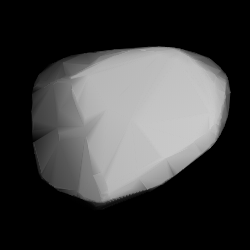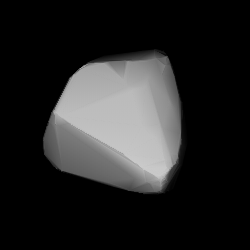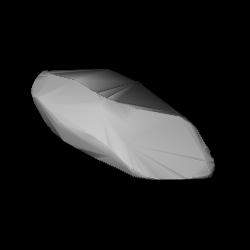Related Research Articles

1125 China (prov. designation: 1957 UN1) is a dark background asteroid from the outer regions of the asteroid belt. It was discovered on 30 October 1957, by astronomer Zhāng Yùzhé (Y. C. Chang, 张钰哲) at the Chinese Purple Mountain Observatory (紫金山天文台) in Nanjing, and named in honor of the country China. The assumed C-type asteroid has a short rotation period of 5.4 hours and measures approximately 26 kilometers (16 miles) in diameter. Its name and number were actually taken from another asteroid that was considered a lost asteroid at the time, but was eventually rediscovered and given the new designation 3789 Zhongguo. "Zhongguo" means "China" in Chinese (1928 UF).

9936 Al-Biruni, provisional designation 1986 PN4, is a carbonaceous asteroid from the outer region of the asteroid belt, approximately 24 kilometers in diameter. It was discovered on 8 August 1986, by Belgian and Bulgarian astronomers Eric Elst and Violeta Ivanova at the Rozhen Observatory, located in Bulgaria's Smolyan province near the border to Greece. It was named for Persian medieval scholar Al-Biruni.
9423 Abt, provisional designation 1996 AT7, is a stony background asteroid from the central region of the asteroid belt, approximately 13 kilometers in diameter. It was discovered on 12 January 1996, by the Spacewatch project of the University of Arizona at Kitt Peak National Observatory, United States. The asteroid was named after American astronomer Helmut Abt.
1717 Arlon, provisional designation 1954 AC, is a binary Florian asteroid from the inner regions of the asteroid belt, approximately 8.5 kilometers in diameter.
1295 Deflotte, provisional designation 1933 WD, is a carbonaceous asteroid from the outer regions of the asteroid belt, approximately 48 kilometers in diameter. It was discovered on 25 November 1933, by French astronomer Louis Boyer at the Algiers Observatory in Algeria, North Africa. The asteroid was named after the discoverer's nephew.

1555 Dejan, provisional designation 1941 SA, is an asteroid from the background population of the central regions of the asteroid belt, approximately 22 kilometers in diameter. It was discovered on 15 September 1941, by Belgian astronomer Fernand Rigaux at the Royal Observatory of Belgium in Uccle. The asteroid was named after Dejan Đurković, son of Serbian astronomer Petar Đurković.
1806 Derice, provisional designation 1971 LC, is a stony Flora asteroid from the inner regions of the asteroid belt, approximately 10 kilometers in diameter. Discovered on 13 June 1971, at the Bickley site of the Perth Observatory in Western Australia, it was the first discovery of a minor planet ever made in Oceania. The asteroid was named after the wife of Dennis Harwood, staff member at Bickley.
1736 Floirac, provisional designation 1967 RA, is a stony Florian asteroid from the inner regions of the asteroid belt, approximately 8.7 kilometer in diameter.
3353 Jarvis, or by its provisional designation, 1981 YC, is a carbonaceous Hungaria asteroid, slow rotator and suspected tumbler from the inner regions of the asteroid belt, approximately 10 kilometers in diameter.
2187 La Silla, provisionally designated 1976 UH, is a stony Eunomia asteroid from the middle region of the asteroid belt, approximately 12 kilometers in diameter.

1361 Leuschneria, provisional designation 1935 QA, is a carbonaceous asteroid from the outer regions of the asteroid belt, approximately 30 kilometers in diameter. It was discovered on 30 August 1935, by Belgian astronomer Eugène Delporte at Uccle Observatory in Belgium, and named after American astronomer Armin Otto Leuschner.
1939 Loretta, provisional designation 1974 UC, is a carbonaceous Themistian asteroid from the outer region of the asteroid belt, approximately 30 kilometers in diameter. It was discovered on 17 October 1974, by American astronomer Charles Kowal at Palomar Observatory in California, who named it after his daughter, Loretta Kowal. The discovery of the asteroid took place during Kowal's follow-up observations of Jupiter's moon Leda, which he had discovered one month prior.

2094 Magnitka (prov. designation: 1971 TC2) is a Flora asteroid from the inner regions of the asteroid belt, approximately 12 kilometers (7.5 miles) in diameter. It was discovered on 12 October 1971, at and by the Crimean Astrophysical Observatory in Nauchnyj, on the Crimean peninsula. The discovery has not been attributed to an observing astronomer. It was later named for the city of Magnitogorsk.

4790 Petrpravec is a carbonaceous background asteroid from the central regions of the asteroid belt, approximately 16 kilometers in diameter. It was discovered on 9 August 1988, by American astronomer Eleanor Helin at the Palomar Observatory in California, and later named for Czech astronomer Petr Pravec.
1731 Smuts, provisional designation 1948 PH, is a carbonaceous asteroid from the outer region of the asteroid belt, approximately 54 kilometers in diameter. It was discovered on 9 August 1948, by South African astronomer Ernest Johnson at Johannesburg Observatory in South Africa, who named it after Field marshal Jan Smuts.
4082 Swann, provisional designation 1984 SW3, is a carbonaceous asteroid from the inner regions of the asteroid belt, approximately 10 kilometers in diameter.
1989 Tatry, provisional designation 1955 FG, is a carbonaceous Vestian asteroid and tumbling slow rotator from the inner regions of the asteroid belt, approximately 16 kilometers in diameter.
1257 Móra, provisional designation 1932 PE, is an asteroid from the inner regions of the asteroid belt, approximately 15 kilometers in diameter. It was discovered on 8 August 1932, by German astronomer Karl Reinmuth at Heidelberg Observatory in southwest Germany. The asteroid was named after Hungarian astronomer Károly Móra.
1608 Muñoz, provisional designation 1951 RZ, is a Flora asteroid from the inner regions of the asteroid belt, approximately 6.5 kilometers in diameter. It was discovered on 1 September 1951, by Argentine astronomer Miguel Itzigsohn at the La Plata Astronomical Observatory, in La Plata, Argentina. The S-type asteroid has a rotation period of 5.3 hours. It was named after F. A. Muñoz, one of the assistant astronomers at the discovering observatory.

7517 Alisondoane is a dark background asteroid from the inner regions of the asteroid belt. It was discovered on 3 January 1989, by Japanese amateur astronomer Takuo Kojima at the YGCO Chiyoda Station in the northern Kantō region of Japan. The carbonaceous C-type asteroid has a rotation period of 9.7 hours and measures approximately 9 kilometers in diameter. It was named after Alison Doane (1958–2017), curator of astronomical photographs at the Harvard College Observatory.
References
- 1 2 3 4 5 6 "JPL Small-Body Database Browser: 5333 Kanaya (1990 UH)" (2017-06-04 last obs.). Jet Propulsion Laboratory . Retrieved 21 June 2017.
- 1 2 3 Schmadel, Lutz D. (2007). "(5333) Kanaya". Dictionary of Minor Planet Names – (5333) Kanaya. Springer Berlin Heidelberg. p. 457. doi:10.1007/978-3-540-29925-7_5141. ISBN 978-3-540-00238-3.
- 1 2 3 4 5 6 "LCDB Data for (5333) Kanaya". Asteroid Lightcurve Database (LCDB). Retrieved 3 May 2016.
- 1 2 3 4 Mainzer, A.; Grav, T.; Masiero, J.; Hand, E.; Bauer, J.; Tholen, D.; et al. (November 2011). "NEOWISE Studies of Spectrophotometrically Classified Asteroids: Preliminary Results". The Astrophysical Journal. 741 (2): 25. arXiv: 1109.6407 . Bibcode:2011ApJ...741...90M. doi:10.1088/0004-637X/741/2/90 . Retrieved 3 May 2016.
- 1 2 Masiero, Joseph R.; Mainzer, A. K.; Grav, T.; Bauer, J. M.; Cutri, R. M.; Dailey, J.; et al. (November 2011). "Main Belt Asteroids with WISE/NEOWISE. I. Preliminary Albedos and Diameters". The Astrophysical Journal. 741 (2): 20. arXiv: 1109.4096 . Bibcode:2011ApJ...741...68M. doi:10.1088/0004-637X/741/2/68 . Retrieved 5 December 2016.
- 1 2 3 4 Usui, Fumihiko; Kuroda, Daisuke; Müller, Thomas G.; Hasegawa, Sunao; Ishiguro, Masateru; Ootsubo, Takafumi; et al. (October 2011). "Asteroid Catalog Using Akari: AKARI/IRC Mid-Infrared Asteroid Survey". Publications of the Astronomical Society of Japan. 63 (5): 1117–1138. Bibcode:2011PASJ...63.1117U. doi:10.1093/pasj/63.5.1117. (online, AcuA catalog p. 153)
- 1 2 Behrend, Raoul. "Asteroids and comets rotation curves – (5333) Kanaya". Geneva Observatory . Retrieved 3 May 2016.
- 1 2 Higgins, David; Pravec, Petr; Kusnirak, Peter; Reddy, Vishnu; Dyvig, Ron (September 2006). "Asteroid lightcurve analysis at Hunters Hill Observatory and collaborating stations - summer 2005/6". The Minor Planet Bulletin. 33 (3): 64–66. Bibcode:2006MPBu...33...64H. ISSN 1052-8091 . Retrieved 3 May 2016.
- 1 2 Higgins, David (January 2011). "Period Determination of Asteroid Targets Observed at Hunters Hill Observatory: May 2009 - September 2010". The Minor Planet Bulletin. 38 (1): 41–46. Bibcode:2011MPBu...38...41H. ISSN 1052-8091 . Retrieved 3 May 2016.
- 1 2 Veres, Peter; Jedicke, Robert; Fitzsimmons, Alan; Denneau, Larry; Granvik, Mikael; Bolin, Bryce; et al. (November 2015). "Absolute magnitudes and slope parameters for 250,000 asteroids observed by Pan-STARRS PS1 - Preliminary results". Icarus. 261: 34–47. arXiv: 1506.00762 . Bibcode:2015Icar..261...34V. doi:10.1016/j.icarus.2015.08.007 . Retrieved 3 May 2016.
- 1 2 "5333 Kanaya (1990 UH)". Minor Planet Center. Retrieved 3 May 2016.
- ↑ "MPC/MPO/MPS Archive". Minor Planet Center. Retrieved 3 May 2016.